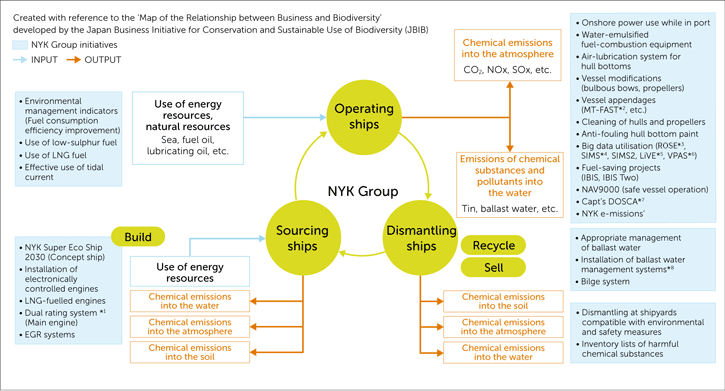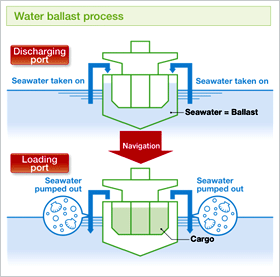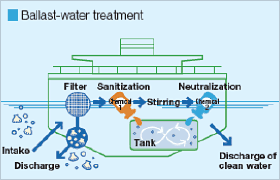Preserving Biodiversity
Mapping the relationship between the NYK Group and biodiversity
NYK have created the below map that shows the impacts on biodiversity of shipping through its lifecycle, and our related efforts, with reference to the "Map of the Relationship between Business and Biodiversity" developed by the Japan Business Initiative for Conservation and Sustainable Use of Biodiversity (JBIB). Recognizing our business activities could affect biodiversity in the entire lifecycle of sourcing, operating and dismantling ships, we will continuously take proactive measures.

- *1Dual rating system
This system allows for the ideal power range to be selected for either high-speed operations or slow-steaming operations. - *2MT-FAST
This is a multi-blade device that can be attached to a ship's hull just in front of its propeller to catch the lost energy from the swirl flow generated by propeller rotation, improving propulsion efficiency while also saving energy. - *3ROSE: Report Of Ship's movement and Environment
- *4SIMS: Ship Information Management System
- *5LiVE: Latest Information for Vessel Efficiency
This system (portal site) aids ship managers in making decisions for realising optimal operation by tracking big data collected through our SIMS/ROSE. - *6VPAS: Vessel Performance Analysis System
This software analyses vessel performance based on the various data collected from the vessel. - *7Capt's DOSCA
This system supplies vessels with up-to-date weather and sea condition forecast information. - *8Ballast water management systems
Seawater (ballast water) is used in ships to maintain ship strength and stability, but oceangoing vessels transport not only the ballast water but also the marine organisms within. A ballast water management system is a system that disinfects organisms and pathogens found within ballast water, using various treatment methods, to prevent the disturbance of an ecosystem.
NYK makes Nature Positive* Declaration
Since NYK recognizes that our environmental DNA sampling of the open ocean and our reforestation project, "Yu no Mori," align with our efforts to realize a nature-positive economy, on October 2024, NYK releases its "Nature Positive Declaration," as encouraged by the Japan Conference for 2030 Global Biodiversity Framework (J-GBF).
- *Nature positive
Halting and reversing biodiversity loss to put nature on a path to recovery.
- More Information:
Endorsement to "Keidanren Initiative for Biodiversity Conservation"
The NYK Group agreed with the "Keidanren Declaration on Biodiversity" and participated as a "Promotion Partner" in December 2010 and also took part in "Japan Business and Biodiversity Partnership in October 2010. In line with the declaration and guidelines, we will conduct our business activities.
- More Information:
Ballast Water Management to Preserve Biological Diversity
To prevent the cross-boundary movement of aquatic organism affecting the marine environment, in 2004 the IMO adopted the International Convention for the Control and Management of Ship's Ballast Water and Sediments. This convention entered into force in September 2017. Ahead of enforcement of the convention, the NYK Group began equipping its car carriers with a ballast water management system*1 that had received formal approval from Japan's Ministry of Land, Infrastructure, Transport and Tourism in 2010. The NYK Group will continue to systematically install ballast water treatment equipment, and it is planned to complete installation on all ships by 2024.


- *1Ballast Water Management System
Seawater (ballast water) is used in ships to maintain ship strength and stability, but oceangoing vessels transport not only the ballast water but also the marine organisms within. A ballast water management system is a system that disinfects organisms and pathogens found within ballast water, using various treatment methods, to prevent the disturbance of an ecosystem.
Realization of a natural symbiotic society utilizing environmental DNA
The NYK Group joins in "ANEMONE*1 Consortium", which is established on June 1, 2022 and cooperates with activities to conserve biodiversity. Environmental DNA, or eDNA is the one derived from living organisms that exists in the environment such as water and soil. By analyzing eDNA, we can learn about the types of organisms that live there. In the future, it is expected that eDNA will be used to visualize biodiversity, leading to the conservation and planned utilization of organisms.
The NYK Group conducts eDNA sampling in the open sea with our operating vessel and provides the samples to Hokkaido University and Tohoku University. The samples were analyzed by the universities and analysis results are released on the ANEMONE Database.
As a member of the ANEMONE Consortium, the NYK Group will continue to contribute to the conservation and restoration of biodiversity.
- *1ANEMONE
ANEMONE stands for All Nippon eDNA Monitoring Network, a biodiversity observation network using environmental DNA.


